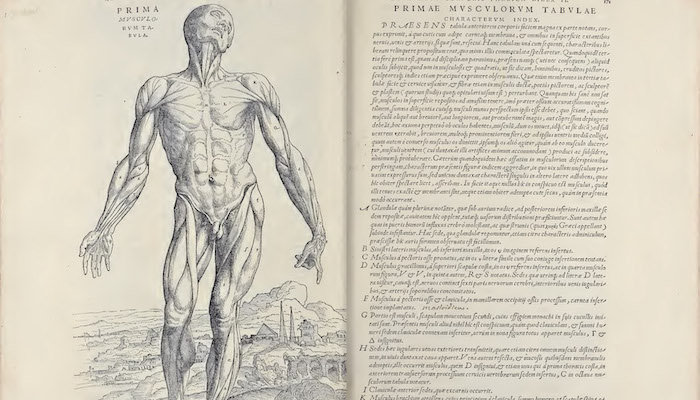
Muscle figure (detail), Jan Steven van Calcar. From Andreas Vesalius, De humani corporis fabrica libri septem (Basel, 1543), bk 1, p. 170–171. Getty Research Institute, 84-B27611
The Polykleitos Problem: Illusions of the Ideal in European Anatomical Images
GETTY CENTER
Ada Louise Huxtable Lecture Hall
This is a past event
Attend In Person: Click on the "Get Tickets" button above to reserve.
Watch Online: Sign up here to watch via Zoom
In De humani corporis fabrica (1543), a foundational volume for modern anatomy, Andreas Vesalius instructs his readers to find and dissect a human body that looks like an ancient Greek sculpture by Polykleitos. Although almost none of the bodies he himself dissected looked that way, the illustrations in his influential publication rely heavily on tropes of antique male muscularity, canonical proportions and direct references to Greek statues.
In contrast to Vesalius's idealized bodies, 16th- and 17th-century anatomical illustrations are rife with varied bodies that push against the primacy of this Greco-Roman canon. Many anatomical treatises portray the human body as more permeable, abstract and resistant to Vesalian norms. This talk by Professor Lyle Massey explores some of the problems confronting early modern anatomists as they tried to define and grasp the human body.
This talk is moderated by Monique Kornell, curator of Flesh and Bones: The Art of Anatomy at Getty Research Institute.
Lyle Massey is associate professor of art history and visual studies at the University of California, Irvine. She has published widely on early modern anatomical imagery, from 17th-century flap sheets to 18th-century Florentine wax figures. She is the author of Picturing Space, Displacing Bodies: Anamorphosis in Early Modern Theories of Perspective, as well as editor and co-editor of The Treatise on Perspective: Published and Unpublished and The Invention of the American Desert: Art, Land, and the Politics of Environment, respectively.
Monique Kornell is a specialist in the history of anatomical illustration and the study of anatomy by artists, with a particular interest in anatomy books for artists. She is the curator of the exhibition Flesh and Bones: The Art of Anatomy and visiting associate professor in the Program in the History of Medicine, Cedars-Sinai Medical Center, Los Angeles.
This program coincides with the exhibition Flesh and Bones: The Art of Anatomy, which is on view through July 10, 2022 at Getty Research Institute.
This program is part of the Untold Stories series, which celebrates the "untold stories" of visual culture, exploring how new works, people, and interpretations can shed fresh light on our understanding of and appreciation for the history of art.
The conversation will be available on the Getty Research Institute YouTube channel following the event.